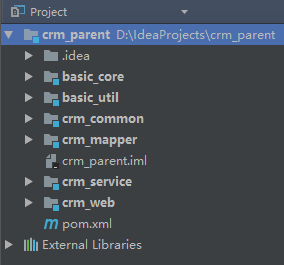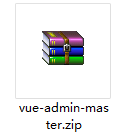1 maven版本的ssm
1.1 最简单的版本步骤:
(1) 创建maven web项目
(2) 在pom.xml中导入依赖的jar包
(3) 再写配置文件:
web.xml
<!DOCTYPE web-app PUBLIC "-//Sun Microsystems, Inc.//DTD Web Application 2.3//EN" "http://java.sun.com/dtd/web-app_2_3.dtd" > <web-app xmlns:xsi="http://www.w3.org/2001/XMLSchema-instance" xmlns="http://java.sun.com/xml/ns/javaee" xsi:schemaLocation="http://java.sun.com/xml/ns/javaee http://java.sun.com/xml/ns/javaee/web-app_3_0.xsd" version="3.0"> <display-name>crm</display-name> <!-- Spring的配置文件 --> <context-param> <param-name>contextConfigLocation</param-name> <param-value>classpath:applicationContext.xml</param-value> </context-param> <!--Spring监听器 ApplicationContext 载入 --> <listener> <listener-class>org.springframework.web.context.ContextLoaderListener</listener-class> </listener> <!-- Spring MVC 核心配置开始 --> <servlet> <servlet-name>springmvc</servlet-name> <servlet-class>org.springframework.web.servlet.DispatcherServlet</servlet-class> <init-param> <param-name>contextConfigLocation</param-name> <param-value>classpath:applicationContext-mvc.xml</param-value> </init-param> <load-on-startup>1</load-on-startup> </servlet> <servlet-mapping> <servlet-name>springmvc</servlet-name> <url-pattern>/</url-pattern> </servlet-mapping> <!-- 编码过滤器 --> <filter> <filter-name>encodingFilter</filter-name> <filter-class>org.springframework.web.filter.CharacterEncodingFilter</filter-class> <init-param> <param-name>encoding</param-name> <param-value>UTF-8</param-value> </init-param> </filter> <filter-mapping> <filter-name>encodingFilter</filter-name> <url-pattern>/*</url-pattern> </filter-mapping> </web-app>
applicationContext.xml
<?xml version="1.0" encoding="UTF-8"?> <beans xmlns="http://www.springframework.org/schema/beans" xmlns:xsi="http://www.w3.org/2001/XMLSchema-instance" xmlns:context="http://www.springframework.org/schema/context" xmlns:tx="http://www.springframework.org/schema/tx" xsi:schemaLocation="http://www.springframework.org/schema/beans http://www.springframework.org/schema/beans/spring-beans.xsd http://www.springframework.org/schema/context http://www.springframework.org/schema/context/spring-context.xsd http://www.springframework.org/schema/tx http://www.springframework.org/schema/tx/spring-tx.xsd"> <!--扫描的包--> <context:component-scan base-package="cn.itsource.crm.service"/> <!-- Jdbc配置文件 --> <context:property-placeholder location="classpath:db.properties" /> <!-- 数据源dataSource --> <bean id="dataSource" class="org.apache.commons.dbcp.BasicDataSource" destroy-method="close"> <property name="driverClassName" value="${jdbc.driverClassName}" /> <property name="url" value="${jdbc.url}" /> <property name="username" value="${jdbc.username}" /> <property name="password" value="${jdbc.password}" /> <!--maxActive: 最大连接数量 --> <property name="maxActive" value="150" /> <!--minIdle: 最小空闲连接 --> <property name="minIdle" value="5" /> <!--maxIdle: 最大空闲连接 --> <property name="maxIdle" value="20" /> <!--initialSize: 初始化连接 --> <property name="initialSize" value="30" /> <!--maxWait: 超时等待时间以毫秒为单位 1000等于60秒 --> <property name="maxWait" value="1000" /> <!-- 在空闲连接回收器线程运行期间休眠的时间值,以毫秒为单位. --> <property name="timeBetweenEvictionRunsMillis" value="10000" /> <!-- 在每次空闲连接回收器线程(如果有)运行时检查的连接数量 --> <property name="numTestsPerEvictionRun" value="10" /> <!-- 1000 * 60 * 30 连接在池中保持空闲而不被空闲连接回收器线程 --> <property name="minEvictableIdleTimeMillis" value="10000" /> <property name="validationQuery" value="SELECT NOW() FROM DUAL" /> </bean> <!--Mybatis核心对象--> <bean id="sqlSessionFactory" class="org.mybatis.spring.SqlSessionFactoryBean"> <!-- 注入数据源 --> <property name="dataSource" ref="dataSource" /> <!-- 配置mybatis (mapper)映射器路径 --> <property name="mapperLocations" value="classpath*:cn/itsource/crm/mapper/*Mapper.xml" /> <!-- 配置mybatis 类型别名 --> <property name="typeAliasesPackage"> <value> cn.itsource.crm.domain cn.itsource.crm.query </value> </property> </bean> <!--注入映射器,一劳永逸的做法--> <bean class="org.mybatis.spring.mapper.MapperScannerConfigurer"> <property name="basePackage" value="cn.itsource.crm.mapper"></property> </bean> <!--事务管理--> <bean id="transactionManager" class="org.springframework.jdbc.datasource.DataSourceTransactionManager"> <property name="dataSource" ref="dataSource"/> </bean> <!--以注解的方式进行事务管理--> <tx:annotation-driven transaction-manager="transactionManager"/> </beans>
applicationContext-mvc.xml
<?xml version="1.0" encoding="UTF-8" ?> <beans xmlns="http://www.springframework.org/schema/beans" xmlns:xsi="http://www.w3.org/2001/XMLSchema-instance" xmlns:context="http://www.springframework.org/schema/context" xmlns:mvc="http://www.springframework.org/schema/mvc" xsi:schemaLocation="http://www.springframework.org/schema/beans http://www.springframework.org/schema/beans/spring-beans.xsd http://www.springframework.org/schema/context http://www.springframework.org/schema/context/spring-context.xsd http://www.springframework.org/schema/mvc http://www.springframework.org/schema/mvc/spring-mvc.xsd"> <!-- 自动扫描该包,使SpringMVC认为包下用了@controller注解的类是控制器 --> <context:component-scan base-package="cn.itsource.crm.web.controller" /> <!-- 启动SpringMVC的注解功能 --> <mvc:annotation-driven/> <!--静态资源放行--> <mvc:default-servlet-handler/> <!-- 定义跳转的文件的前后缀 ,视图解析器配置--> <bean class="org.springframework.web.servlet.view.InternalResourceViewResolver"> <property name="prefix" value="/WEB-INF/views/" /> <property name="suffix" value=".jsp" /> </bean> <!-- 配置文件上传解析器 --> <bean id="multipartResolver" class="org.springframework.web.multipart.commons.CommonsMultipartResolver"> <!-- 默认编码 --> <property name="defaultEncoding" value="utf-8" /> <!-- 文件大小最大值 --> <property name="maxUploadSize" value="10485760000" /> </bean> </beans>
db.properties
jdbc.driverClassName=com.mysql.jdbc.Driver jdbc.url=jdbc:mysql:///crm?useUnicode=true&characterEncoding=utf-8 jdbc.username=root jdbc.password=root
log4j.properties
log4j.rootLogger=ERROR, stdout
#log4j.rootLogger=NONE
log4j.logger.cn.itsource=TRACE
log4j.appender.stdout=org.apache.log4j.ConsoleAppender
log4j.appender.stdout.layout=org.apache.log4j.PatternLayout
(4) 搭建service层,mapper层,controller层
(5) 进行测试
1.2 抽取一些公共的内容的版本
(1) 抽取BaseMapper
把公共的crud方法抽取到BaseMapper里面。
(2) 抽取IBaseService和BaseServiceImpl
把公共的crud方法抽取到BaseService里面,通过BaseServiceImpl去实现BaseService里面的方法。
(3) 抽取BaseDomain
抽取公共的id。
2 maven项目的分模块开发
2.1 为什么需要分模块开发
使用传统的ssm结构,在随着项目的进行,我们可能遇到下面一系列的问题:
(1) 大部分的domain或者一些service以及mapper在多个项目中是通用的
(2) pom.xml中的依赖越来越长
(3) build整个项目的时间越来越长,尽管你只是一直在web层工作,但是不得不build整个项目
(4) 某个模块,比如mapper,你只想让一些经验丰富的人来维护,但是现在每个开发者都能修改这个模
块,这导致关键模块的代码质量达不到你的要求
2.2 什么是分模块开发
一个大项目拆分为多个小项目(maven模块)组成,而且它们是有依赖关系的。
2.3 怎么去分模块开发
写项目写代码尽量满足以下内容:
(1) 开闭原则
对扩展开放
对修改关闭-->公共的不要乱修改
(2) 高内聚:比如一个方法(方法就应该完成一个方法该干的事情) -- 最多40行
低耦合:尽量的分层开发 mapper service controller(方便维护)
拆分:
按照层次结构拆分
按照业务功能拆分:电商、订单、物流……
(1) 代码拆分
basic-util 工具类
basic-core 公共内容
crm-common 具体项目公共内容
crm-mapper 项目里面具体mapper
crm-web 项目的controller层
……
pss-common
(2) 配置文件拆分
web.xml / applicationContext-mvc.xml --> crm-web模块
applicationContext.xml --> crm-service模块
(3) 效果

3 RESTful风格
RESTful是一种开发理念,是设计风格而不是标准。 REST描述的是在网络中client和server的一种交互形式;REST本身不实用,实用的是如何设计 RESTful API(REST风格的网络接口),一种万维网软件架构风格。
前端代码 --> 后端代码进行交互,交互的时候前端代码(axios)发送请求到后端代码
axios --> get / post / put / delete / patch
3.1 RESTful风格理解
<a href="/xxx"> --> get
<form method="post"> --> post
ajax --> get/post
除了get/post以外,还支持其他请求 put/delete/patch --> http协议扩展出来的
没有RESTful以前:
/addUser?name='Bob'&age=38 -- get
/delete?id=1
=====================================华丽的分割线=============================================
RESTful风格:传输请求风格写法 -- http get/post/patch/put/delete 完成增删改查:
(1) put动作 + /user(资源路径) {"name":"Bob","age":28} --> 新增
(2) post动作 + /user(资源路径) {"name":"Bob","age":28} --> 修改
(3) delete 动作 +/user/1 --> 表示删除id为1的用户
(4) get 动作 + /user/10 --> 查询id为10的用户
(5) patch 动作 + /user --> 批量查询
那么为什么要使用RESTful?
安全性好一点,现在比较流行的风格,不会暴露动作
3.2 RESTful代码实现
以下为测试代码:
新增:
/** * 新增数据 */ @RequestMapping(method = RequestMethod.PUT) @ResponseBody public AjaxResult save(@RequestBody Department department) { System.out.println("新增数据为:" + department); return new AjaxResult(); }
修改:
/** * 修改数据 */ @RequestMapping(method = RequestMethod.POST) @ResponseBody public AjaxResult update(@RequestBody Department department) { System.out.println("修改数据为:" + department); return new AjaxResult(); }
删除:
/** * 删除数据 */ @RequestMapping(value = "{id}", method = RequestMethod.DELETE) @ResponseBody public AjaxResult delete(@PathVariable Long id) { System.out.println("删除一条数据id为:" + id); return new AjaxResult(); }
查询一条:
/** * 查询一条数据 */ @RequestMapping(value = "{id}", method = RequestMethod.GET) @ResponseBody public AjaxResult findOne(@PathVariable Long id) { System.out.println("查询一条数据id为:" + id); return new AjaxResult(); }
查询所有:
/** * 查询所有 */ @RequestMapping(value = "/list",method = RequestMethod.PATCH) @ResponseBody public List<Department> findAll() { return departmentService.findAll(); }
4 swagger(前端人员使用很多)
实现
<springfox.version>2.4.0</springfox.version> <dependencies> <dependency> <groupId>io.springfox</groupId> <artifactId>springfox-swagger2</artifactId> <version>${springfox.version}</version> </dependency> <dependency> <groupId>io.springfox</groupId> <artifactId>springfox-swagger-ui</artifactId> <version>${springfox.version}</version> </dependency>
package cn.itsource.crm.web.config; import org.springframework.context.annotation.Bean; import org.springframework.context.annotation.ComponentScan; import org.springframework.context.annotation.Configuration; import org.springframework.web.servlet.config.annotation.EnableWebMvc; import springfox.documentation.builders.PathSelectors; import springfox.documentation.builders.RequestHandlerSelectors; import springfox.documentation.service.ApiInfo; import springfox.documentation.spi.DocumentationType; import springfox.documentation.spring.web.plugins.Docket; import springfox.documentation.swagger2.annotations.EnableSwagger2; @Configuration //相当于写一个配置文件 application.xml @EnableWebMvc // 开启springmvc @EnableSwagger2 //开启swagger2 @ComponentScan(basePackages="cn.itsource.crm.web.controller") public class SwaggerConfig { //相当于 <bean ><property name=""> </bean> @Bean public Docket api(){ //生成接口信息 return new Docket(DocumentationType.SWAGGER_2) .apiInfo(this.apiInfo()) .select() .apis(RequestHandlerSelectors.basePackage("cn.itsource.crm.web.controller")) .paths(PathSelectors.any()) .build(); } //api的 注解 javaweb 文档的描述信息 private ApiInfo apiInfo(){ @SuppressWarnings("deprecation") ApiInfo info=new ApiInfo( "API接口测试文档", "接口测试", "1.0", "http://www.itsource.cn", "itsource", "123", "http://www.itsource.cn"); return info; } }
和spring整合,根据controller 生成的接口的文档,通过页面访问
运行:http://localhost/swagger-ui.html
5 postman
postman就是一个工具,可以来发送各种http请求,可以用它来测试http协议接口。
postman就是http协议接口测试工具。
测试 put/get/post/delete/patch这些请求:

6 前端vue-element-admin
基于 vue-cli 和 elementui 搭建出来一个模块框架,框架基本功能,路由,插件,国际化等
搭建模板:
(1) 解压文件 --修改名称

(2) 使用idea 打开
(3) 执行命令 npm install 安装依赖
(4) 启动 npm run dev


 posted on
posted on
